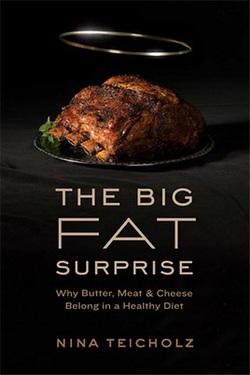
The Big FAT Surprise: Why Butter, Meat & Cheese Belong in a Healthy Diet by Nina Teicholz, Simon and Schuster, 2014.
Let me say that I hope Teicholz makes a ton of money from this book. She deserves that, having spent the past nine years doing the research for the 337 pages of text plus 100+ pages of notes that comprise this book. And the message is: Whatever you think you know about what current research tells us constitutes healthy eating, you’re almost certainly wrong. If you go back and actually look at the original data for the studies that have been so influential in our dietary thinking over the past few decades, as Teicholz has done, you’ll find that they don’t actually say what it’s been said that they say.
So, for example, take a look at the so-called “Mediterranean Diet,” beloved in song and story. What does it consist of? Lots of vegetables, lots of whole grains, fish, and the very occasional serving of red meat. The fat of choice is olive oil, gallons of it.
Sounds pretty good, doesn’t it? I can just see the old arteries getting sluiced down with all this good stuff. But the problem is that there are some very basic issues with saying that this diet represents the whole Mediterranean area. If you think about it, and I hadn’t, the Mediterranean Sea is a pretty big body of water, with a correspondingly big choice of countries surrounding it. So what’s a typical diet from this area? There isn’t one. The way people eat in southern Spain is very different from the way they eat in northern Africa, or Greece, or Turkey, or the Riviera. Guess who poured gallons of money into this study that said there was commonality, especially in the fat used? The IOOC, or International Olive Oil Council. Olive oil is apparently a perfectly sensible oil to use in the diet, but the hype associating it with health and longevity is pretty overblown. And the use of olive oil for food isn’t all that ancient, it seems. Its primary uses in the centuries before around 1880 were for religious rituals, lighting, and cosmetics. Apparently, lard was the cooking fat of choice for most people in the region. Israel is a Mediterranean country too, of course, and it’s interesting to note that Psalm 104:15: specifically lists oil (almost certainly olive oil) as something “to make [mankind’s] faces shine.” Nothing there about pouring the stuff down your gullet.
I could go on with other examples of the penetrating analysis in this book. Let me instead include a quotation summing up the original research on this particular regimen: “In the end, it turned out that only thirty to thirty-three men were sampled on Crete and thirty-four on Corfu. These, then, are the founding men of the Mediterranean Diet, whose meals over the course of a few weeks fifty years ago have influenced the entire course of nutrition history in the Western Hemisphere” (217). Isn’t that fascinating? What has seemed to be overwhelming evidence that eating a certain way will produce health turns out, in the end, to be based on . . . nothing much at all. If you find this as intriguing as I do, all I can say is, read this book.